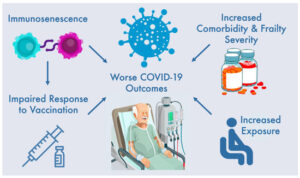
Source – https://doi.org/10.3390/biomedicines11030926
Introduction
The article by Annette Bruchfeld, published in Nature Reviews Nephrology (February 2021) provides a timely analysis of COVID-19’s impact on nephrology. The article effectively summarises early research findings from 2020 regarding the relationship between COVID-19 and kidney disease. This review will evaluate the article’s scientific merits, methodological approach, findings, limitations, and contributions to the field.
Methods Assessment
The article employs a narrative review methodology to synthesise evidence from multiple studies published during the initial year of the COVID-19 pandemic. While not a systematic review or meta-analysis, the author carefully selected significant studies from diverse geographical regions, focusing primarily on large population datasets from the US, UK, and Europe. The approach appropriately balances breadth and depth given the rapidly evolving nature of COVID-19 research at the time.
Results Analysis
Bruchfeld effectively organises the evidence into two main categories:
1. COVID-19 risk in kidney disease populations:
– The article establishes chronic kidney disease (CKD) as a significant risk factor for severe COVID-19 and mortality, citing evidence from China and large cohort studies from New York and the UK.
– The review highlights particularly concerning outcomes for dialysis patients and transplant recipients, with 28-day mortality risks approximately 20 times higher than matched controls.
– The author thoroughly documents the elevated SARS-CoV-2 seroprevalence among dialysis patients (3.5-27.2%), far exceeding general population rates.
2. Kidney complications in COVID-19 patients:
– The article comprehensively documents acute kidney injury (AKI) as a frequent complication of COVID-19, occurring in up to 50% of hospitalised patients.
– It appropriately emphasises the significantly increased mortality (50-63%) among COVID-19 patients requiring dialysis for AKI.
– The review presents evidence that while most surviving patients recover kidney function, 30-36% still demonstrate impairment at discharge.
Discussion Evaluation
The author provides a balanced analysis of the bidirectional relationship between COVID-19 and kidney disease, effectively synthesising available evidence. The discussion is appropriate.
1. Addresses potential pathophysiological mechanisms of COVID-19-related kidney injury, including viral septicemia, inflammation, endothelial damage, hypercoagulability, and hypoxia.
2. Evaluates treatment options relevant to nephrology, though limited at the time to remdesivir and dexamethasone, noting the exclusion of advanced CKD patients from the remdesivir trial.
3. Considers practical implications for nephrology care, including the potential long-term burden on healthcare systems.
4. Identifies key questions requiring further investigation, particularly regarding the long-term risk of CKD development following COVID-19 infection.
Limitations
Several limitations should be noted:
1. The article’s timing (early in the pandemic) means it lacks insights from longer-term follow-up studies that would better characterise persistent kidney dysfunction.
2. The review focuses heavily on hospital-based studies, potentially overlooking outpatient manifestations of kidney involvement.
3. The pathophysiological discussion remains speculative in parts, reflecting the limited mechanistic understanding available at publication.
4. The review does not extensively address disparities in outcomes across different demographic groups beyond age and sex.
Significance and Implications
Despite these limitations, the article makes valuable contributions by:
1. Synthesising early evidence establishing kidney disease as both a risk factor for and a consequence of COVID-19.
2. Highlighting the disproportionate impact on patients with pre-existing kidney conditions.
3. Raising important questions about long-term nephrology resource planning and the potential for COVID-19 to increase future CKD burden.
4. Proposing practical mitigation strategies for high-risk kidney patients, including remote care, telemedicine, and home dialysis options.
Conclusion
Bruchfeld’s review represents a scientifically sound summary of early evidence regarding COVID-19’s impact on nephrology. The article effectively communicates the bidirectional relationship between kidney disease and COVID-19, identifying key risk factors and outcomes while acknowledging limitations in the available evidence. The review serves as an important foundation for subsequent research on long-term kidney outcomes in COVID-19 survivors and continues to inform clinical practice in nephrology during the pandemic.
original article – https://www.nature.com/articles/s41581-020-00381-4.pdf
![]()

